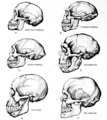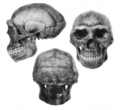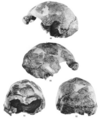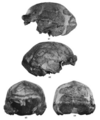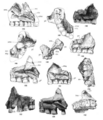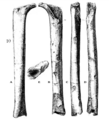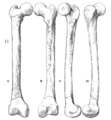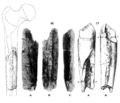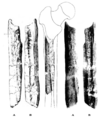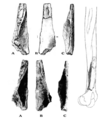Peking Man facts for kids
Quick facts for kids Peking ManTemporal range: Pleistocene
|
|
|---|---|
| Scientific classification | |
| Kingdom: | |
| Subphylum: | |
| Class: | |
| Order: | |
| Family: | |
| Genus: | |
| Species: | |
Peking Man is the name given to a very old group of human ancestors. They are a type of Homo erectus, which means "upright man." Their remains were first found between 1923 and 1937. These important discoveries happened during digs at a place called Zhoukoudian, which is near Beijing in China.
Contents
What is Peking Man?
Peking Man is a special example of Homo erectus, an early human species. Scientists now call this specific group Homo erectus pekinensis. These ancient humans lived a very long time ago.
When Did They Live?
In 2009, scientists used special methods to figure out how old the Peking Man remains are. They found that these early humans lived roughly 750,000 years ago. More recent studies suggest they lived between 680,000 and 780,000 years ago. That's almost a million years ago!
What Do We Know About Them?
Sadly, the original fossils of Peking Man disappeared in 1941. But, scientists had already made detailed copies, called casts, and written descriptions. These copies help us understand what Peking Man was like.
- Appearance: Peking Man looked similar to modern humans and to Neanderthals, another ancient human group.
- Tools: They were skilled at making and using stone tools. These tools helped them with daily tasks like hunting and preparing food.
- Fire: It is very likely that Peking Man knew how to use fire. Fire would have provided warmth, protection from animals, and a way to cook food.
- Family Tree: Scientists are still studying if Peking Man is a direct ancestor of modern humans (Homo sapiens). They also want to know if they mixed with other ancient groups, like the Denisovans, who lived in East Asia. There is still much to learn about their place in the human family tree.
Images for kids
-
Bust of Peking Man at the National Museum of China
-
Ernst Haeckel suggested early humans dispersed across the now-disproven hypothetical continent "Lemuria" (above).
-
1936 restorations of various fossil skulls (note the Piltdown Man was declared a hoax in 1953 and the Peking Man skull was revised in 1937 and again in 1996.)
-
Maxillae from Skulls III, V, VI, and X
See also
 In Spanish: Hombre de Pekín para niños
In Spanish: Hombre de Pekín para niños






